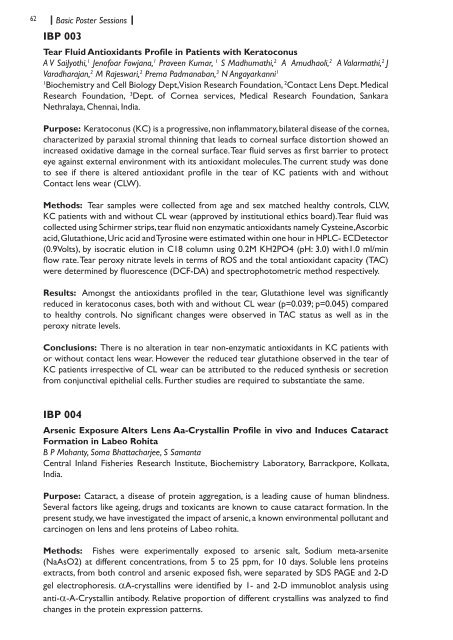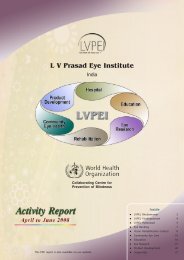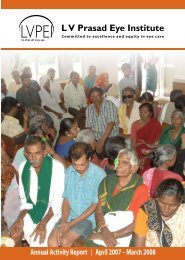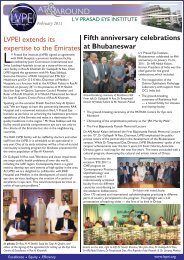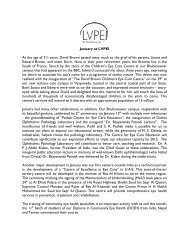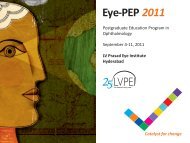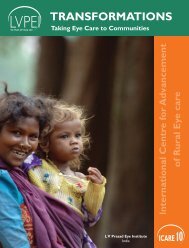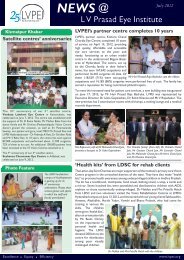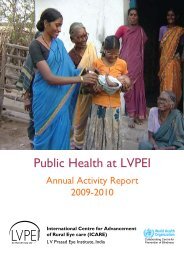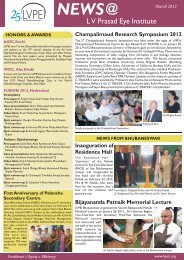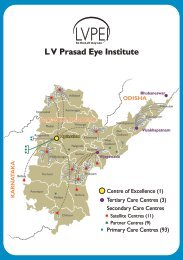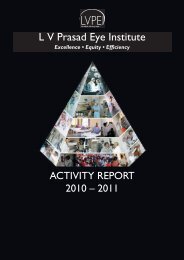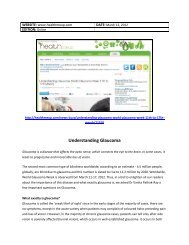IERG Abstracrt Book.indd - LV Prasad Eye Institute
IERG Abstracrt Book.indd - LV Prasad Eye Institute
IERG Abstracrt Book.indd - LV Prasad Eye Institute
You also want an ePaper? Increase the reach of your titles
YUMPU automatically turns print PDFs into web optimized ePapers that Google loves.
62 Basic Poster SessionsIBP 003Tear Fluid Antioxidants Profile in Patients with KeratoconusA V SaiJyothi, 1 Jenofoar Fowjana, 1 Praveen Kumar, 1 S Madhumathi, 2 A Amudhaoli, 2 A Valarmathi, 2 JVaradharajan, 2 M Rajeswari, 2 Prema Padmanaban, 3 N Angayarkanni 11Biochemistry and Cell Biology Dept, Vision Research Foundation, 2 Contact Lens Dept. MedicalResearch Foundation, 3 Dept. of Cornea services, Medical Research Foundation, SankaraNethralaya, Chennai, India.Purpose: Keratoconus (KC) is a progressive, non inflammatory, bilateral disease of the cornea,characterized by paraxial stromal thinning that leads to corneal surface distortion showed anincreased oxidative damage in the corneal surface. Tear fluid serves as first barrier to protecteye against external environment with its antioxidant molecules. The current study was doneto see if there is altered antioxidant profile in the tear of KC patients with and withoutContact lens wear (CLW).Methods: Tear samples were collected from age and sex matched healthy controls, CLW,KC patients with and without CL wear (approved by institutional ethics board).Tear fluid wascollected using Schirmer strips, tear fluid non enzymatic antioxidants namely Cysteine, Ascorbicacid, Glutathione, Uric acid and Tyrosine were estimated within one hour in HPLC- ECDetector(0.9Volts), by isocratic elution in C18 column using 0.2M KH2PO4 (pH: 3.0) with1.0 ml/minflow rate. Tear peroxy nitrate levels in terms of ROS and the total antioxidant capacity (TAC)were determined by fluorescence (DCF-DA) and spectrophotometric method respectively.Results: Amongst the antioxidants profiled in the tear, Glutathione level was significantlyreduced in keratoconus cases, both with and without CL wear (p=0.039; p=0.045) comparedto healthy controls. No significant changes were observed in TAC status as well as in theperoxy nitrate levels.Conclusions: There is no alteration in tear non-enzymatic antioxidants in KC patients withor without contact lens wear. However the reduced tear glutathione observed in the tear ofKC patients irrespective of CL wear can be attributed to the reduced synthesis or secretionfrom conjunctival epithelial cells. Further studies are required to substantiate the same.IBP 004Arsenic Exposure Alters Lens Aa-Crystallin Profile in vivo and Induces CataractFormation in Labeo RohitaB P Mohanty, Soma Bhattacharjee, S SamantaCentral Inland Fisheries Research <strong>Institute</strong>, Biochemistry Laboratory, Barrackpore, Kolkata,India.Purpose: Cataract, a disease of protein aggregation, is a leading cause of human blindness.Several factors like ageing, drugs and toxicants are known to cause cataract formation. In thepresent study, we have investigated the impact of arsenic, a known environmental pollutant andcarcinogen on lens and lens proteins of Labeo rohita.Methods: Fishes were experimentally exposed to arsenic salt, Sodium meta-arsenite(NaAsO2) at different concentrations, from 5 to 25 ppm, for 10 days. Soluble lens proteinsextracts, from both control and arsenic exposed fish, were separated by SDS PAGE and 2-Dgel electrophoresis. aA-crystallins were identified by 1- and 2-D immunoblot analysis usinganti-a-A-Crystallin antibody. Relative proportion of different crystallins was analyzed to findchanges in the protein expression patterns.


